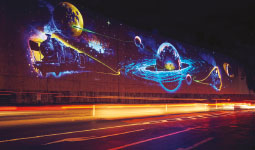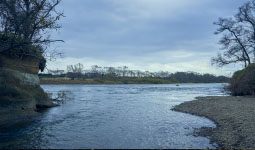Home > Highlighting JAPAN > Highlighting Japan February 2019 > Sharing Japanese Literature with the World
Highlighting JAPAN


Home to the Dreamer: Kenji Miyazawa and Hanamaki City
Three hours by bullet train from Tokyo Station, Hanamaki City is known as the place where one of Japan’s most prominent and prolific Japanese authors, Kenji Miyazawa, was born and lived. Unsung in his short lifetime, the highly intellectual writer left behind a legacy of imaginative worlds that have enchanted readers for decades.
Ginga Tetsudo no Yoru (Night on the Galactic Railroad), Chuumon no Ooi Ryouriten (The Restaurant of Many Orders), Sero Hiki no Goshu (Gauche the Cellist), Yodaka no Hoshi (The Nighthawk Star)—most Japanese people can name these Kenji Miyazawa literary works, many of which are read in elementary schools.
During his lifetime, however, Miyazawa was an unknown who wrote his fiction while working a day job. From 1921, Miyazawa was a teacher at Hanamaki Agricultural School (currently Iwate Prefectural Hanamaki Agricultural High School) for six years from the age of twenty-five. He then founded the Rasu Chijin Kyokai, or Rasu Farmers Association, which was actually a private school where he lectured on subjects such as agricultural technology and agricultural art theory. He supported local farmers by teaching them about fertilizers and effective agricultural techniques until his untimely death at the age of thirty-seven.
“Kenji Miyazawa was a prolific writer,” says Akihiro Miyazawa, curator of the Miyazawa Kenji Museum and the grandson of Miyazawa’s brother Seiroku. “Besides about a hundred works of fiction for children, he also wrote between 900 and 1000 poems, and also wrote tanka poems, plays, song lyrics and more. He wrote such an enormous number of tanka that many are not well-known.”
Miyazawa’s erudition was the foundation of this immense body of work. He was knowledgeable about various fields and quick to pounce on the latest in world news. “Night on the Galactic Railroad, for example, has a scene about people who died on the Titanic. Although he lived in a remote region, he had a tremendously sensitive antenna for world events,” notes the curator.
The Miyazawa Kenji Museum divides its exhibits into five themes that represent the author’s views of the world and the universe: science, art, space, religion and agriculture. However, “the extent and the depth of his interests went well beyond this categorization,” says Miyazawa, admiring the author’s inexhaustible interest in the world around him.
The writer gathered information from the world over, reflected upon it and then reconstructed the world into a form that the students in his classes or farmers in Hanamaki would understand. His ideas may well have been ahead of their time. In an age when phones were still uncommon and the Internet only a distant dream, it is not difficult to imagine how people must have reacted to these glimpses of distant worlds.
Although Miyazawa’s global perspective is at the heart of what makes his works interesting, very few likely understood his worldview back then. The museum’s curator reckons that he wanted to send something out to the world from Hanamaki, but it is now impossible to know what.
Another element running through Kenji Miyazawa’s writing is his devotion to Buddhism. “Although time passes, his works never feel out of date,” says Miyazawa, “probably because they are based on the Buddhist concept of universality. That may also be the reason his works have been translated and read in more than twenty countries.”
Kenji Miyazawa left behind a tremendous trove of writing, most of which seemed to be just scrawled and tossed aside. His brother Seiroku Miyazawa organized, categorized and preserved it all after his death. “I took over the work my grandfather deeply cared for, and now people in Hanamaki care for it as well,” the curator says. “The Miyazawa Kenji Museum was built in commemoration fifty years after his death. About ten thousand visitors come to visit the museum from all over Japan and the world every year.”
Hanamaki also preserves various places associated with its native son, including the “English Coast”—a rock formation that reminded the author of Dover; the former site of the Rasu Farmers Association, marked by a monument featuring his poem “Amenimo Makezu” (Strong in the Rain); and his home. Miyazawa’s footsteps can be found here and there in Hanamaki, mirroring the community-wide respect for him.
When in Hanamaki, take time to gaze over the landscape and put yourself in his shoes. Only here can you immerse yourself in Kenji Miyazawa’s world and connect with the fantastical worlds this beloved author created.
© 2009 Cabinet Office, Government of Japan










